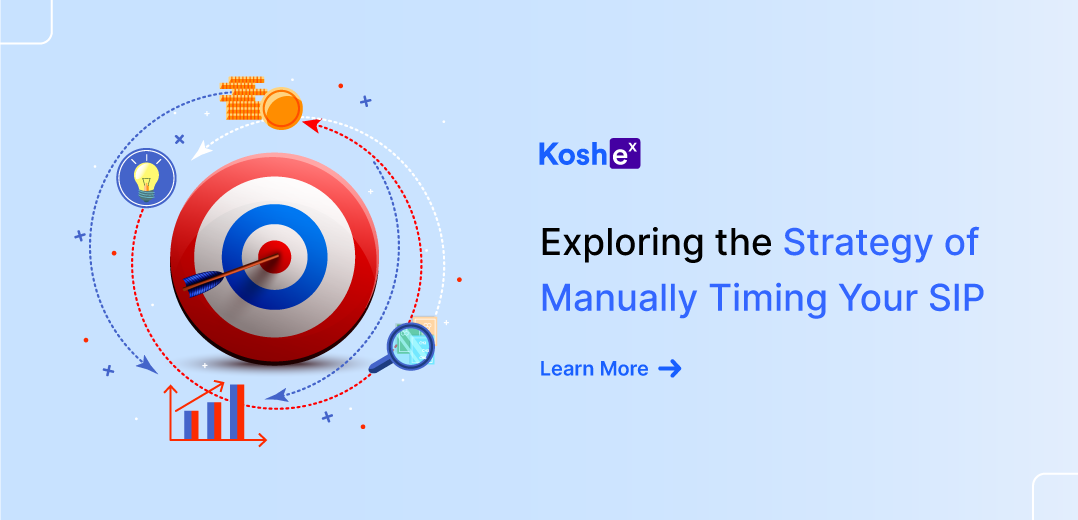Are you curious about the strategy of manually timing your Systematic Investment Plans (SIPs)? Many investors wonder if it is better to invest the same amount every month or to time their investments based on the net asset value (NAV) of units.
This insightful article explores the pros and cons of manually timing your SIPs, drawing insights from industry analysis. While some argue that timing SIPs may lead to behavioral errors and lack of advantage, others believe it can optimize returns.
By examining different perspectives and understanding the details, you can decide whether manually timing your SIPs aligns with your investment goals. Let’s uncover the secrets of this strategy and embark on a journey to enhance your investment prowess. Sign up with Koshex today!
Understanding Systematic Investment Plans (SIPs)
SIPs are a popular investment mode that allows individuals to invest a fixed amount regularly in mutual funds. This disciplined approach enables investors to participate in the stock market with small and regular investments. SIPs offer numerous benefits, including convenience, flexibility, and the power of compounding.
Instead of investing in a lump sum, investors contribute a fixed sum at regular intervals, usually every month. This approach eliminates the need to time the market, as investments are made at different market levels over time.
By investing consistently, investors benefit from rupee cost averaging, which means buying more units when prices are low and fewer units when prices are high.
One of the key advantages of SIPs is that they instill financial discipline and encourage regular saving habits. By committing to invest a fixed amount every month, individuals develop a habit of saving and investing, even during market fluctuations.
SIPs also provide the flexibility to start with a small investment amount, sometimes as low as Rs. 100, making it accessible to all investors.
Basics of Manually Timing Your SIPs
The essence of manually timing your SIPs lies in closely monitoring the stock market and adjusting your investment amount based on market conditions.
Advocates of this strategy argue that by investing a larger amount when the NAV is low, investors can potentially maximize their returns. However, it is important to approach this strategy with caution.
Firstly, timing the market consistently and accurately is challenging, even for experienced investors. Market movements can be unpredictable, making it difficult to determine the optimal entry points accurately.
Secondly, attempting to time the market can increase the chances of behavioral errors, such as panic selling during market downturns or chasing short-term trends.
Experts suggest that investors should focus on the power of compounding and rupee cost averaging rather than trying to time the market.
By investing a fixed amount regularly, regardless of market conditions, investors benefit from averaging their purchase price over time. This approach helps mitigate the impact of short-term market fluctuations and smooth out the investment journey.
SIPs offer several advantages, starting with a low investment amount, often as low as Rs. 100. They allow investors to choose the mutual fund and contribute at regular intervals, aligning with their financial goals and saving capacities.
Furthermore, SIPs allow investors to participate in the potential growth of the stock market while spreading the investment risk.
Pros and Cons of Manual Timing
When investing in SIPs, manually timing your investments or sticking to regular intervals is a heated debate.
Let’s explore the potential benefits and drawbacks of this strategy.
Pros of Manual Timing
- Seizing Market Opportunities: By closely monitoring market movements, investors can potentially capitalize on favorable conditions, such as investing a larger amount when the market is down or the NAV is low. This approach aims to maximize returns by taking advantage of potentially undervalued assets.
- Flexibility and Control: Manual timing gives investors control and flexibility over their investment decisions. It allows for adjustments based on personal analysis and market research. Investors find manual timing appealing as it aligns with their investment philosophy and offers a hands-on approach.
- Potential for Higher Returns: Manual timing can yield higher returns compared to investing at regular intervals. By entering the market during opportune moments, investors may benefit from purchasing lower-priced assets and participating in a market upswing.
Cons of Manual Timing
- Market Timing Challenges: Timing the market accurately is an incredibly challenging task. Even seasoned professionals struggle with consistently predicting market movements. Investors attempting manual timing may fall victim to behavioral biases, such as emotional decision-making, leading to poor investment choices and potential losses.
- Increased Risk: Manual timing introduces a higher level of risk compared to regular interval investments. By deviating from a disciplined and consistent approach, investors may expose themselves to greater volatility and potential losses. Inaccurate timing decisions can result in missed opportunities or unfavorable market entry.
- Emotional Stress: Constantly monitoring market conditions and making manual timing decisions can lead to emotional stress and anxiety. Market fluctuations may consume investors, leading to impulsive and irrational decisions. This emotional rollercoaster can impact long-term financial goals and overall peace of mind.
Conclusion
The strategy of manually timing your SIPs is a subject of great interest among investors. While it offers potential benefits such as seizing market opportunities and providing flexibility, it also comes with challenges.
As with any investment strategy, it’s crucial to consider your risk tolerance and financial goals before deciding whether manual timing aligns with your objectives. It’s worth noting that SIPs, with their consistent and disciplined approach, offer numerous advantages.
Investors can navigate market fluctuations and benefit from long-term growth potential by focusing on the power of compounding and rupee cost averaging. Starting with a low investment amount, as low as Rs. 100, and having the flexibility to choose a mutual fund of their choice further enhances the appeal of SIPs.
Sign up with Koshex and unlock your financial potential. Start a SIP and receive personalized investment recommendations for accelerated wealth growth.
Also check the SIP Calculator Calculate Returns on SIP Investment
FAQs
Q1. What is the significance of net asset value (NAV) in SIPs?
Ans. NAV in SIPs is significant as it determines the value of a mutual fund’s assets per unit. It helps investors track the performance of their investments, allocate their investment amount, calculate costs, and make comparative analyses. NAV plays a crucial role in determining the number of units an investor can purchase with their SIP investment amount.
Q2. Is it possible to switch from manual timing to regular intervals in SIPs?
Ans. Investors can adjust their investment strategy based on their changing preferences and goals. They can transition from manually timing their SIPs, making investments based on market conditions, to opting for regular investment, where they invest a fixed amount at predefined intervals.









Leave a Comment